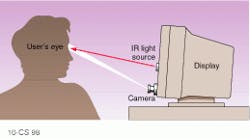PC users can surf the Web with a blink of the eye
Robert Chappell
Lou Gehrig’s disease, carpal-tunnel syndrome, and even tendonitis can severely limit a person’s ability to simply click a personal-computer (PC) mouse button. One solution is to use an eye-tracking system to run the software application. As the eye moves, the cursor tracks along. A slow blink replaces a mouse click.
The eye-tracking technique is not new. A valid research tool for many years now, it has been used to observe eye motion in applications ranging from human-interface design of aircraft-instrument panels to evaluation of the effectiveness of advertising layouts. Such systems, however, are usually dedicated to specific applications and have price tags exceeding tens of thousands of dollars.
Another option is the Quick Glance system, which, for about $2500, allows eye control of the cursor in any existing Windows 95-based software application. Required equipment includes an infrared digital camera with light-emitting-diode (LED) sources, a frame grabber to digitize the video image from the camera, and software to process the digital image and control the cursor. Minimum hardware requirements are a Pentium 120 PC with an available PCI slot, the Windows 95 operating system, 16-Mbyte RAM, and a 17- or 21-in. monitor.
Following the pupil
Aside from hardware, the Windows-based image-processing system has specific user requirements. A person must have good control of eye movements for the eye selected for tracking and also must be able to hold his or her head relatively still while using the system. With help from an on-screen position tracker, the system user must also maintain the tracking eye within the camera’s field of view (about 4.5 cm wide × 3.5 cm high at about 55 cm from the screen).
With a 50-mm lens, the camera has a field of view that tolerates some head motion, so users do not have to hold their heads perfectly still. To determine that the eye has moved to focus on a different spot on the computer screen, Quick Glance will factor out head movement with a technique that has been known for years: reflections from the eye’s cornea remain stationary when the head moves. Thus, by measuring any change in the location of the pupil relative to a stationary reflection from the cornea, the system can tell if the pupil has moved.
The Windows-based system illuminates the eye with two arrays of infrared LEDs mounted on the computer (see figure). Images of the LED arrays reflect back from the cornea as bright spots. The camera picks up an image of the eye, including the pupil and the LED reflections. By registering only infrared light, it can eliminate the majority of unwanted reflections caused by other light sources in the room.
The digital camera outputs the image as a standard analog video image, like a television signal, to a PXC200 frame grabber from Imagenation Inc. (Beaverton, OR) installed in the computer. Triggered by the software, it captures a new image at the rate of about 10 frames/s and converts the analog image into a digital one suitable for processing.
The software uses image-processing techniques to locate the pupil of the eye and the two bright spots reflected from the LEDs. It then calculates the distance from the pupil to the bright spots and compares that distance to the previous measurement. A change indicates that the user`s gaze has shifted, and the computer operating system then moves the mouse cursor to the new location.
Programmed to ignore normal, rapid eye blinks, the imaging system will send a command to the operating system that "the mouse button has been clicked" when there is a long eye blink, with the eye closed for multiple frames. An on-screen toolbar provides additional control options by allowing users to change the effect of an eye blink.
